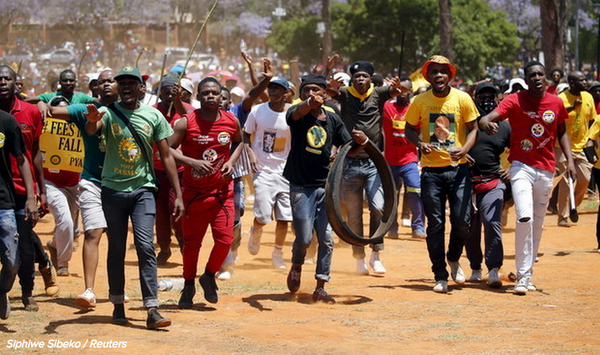ANC leadership shaken by electrifying ten days
Weizmann Hamilton, Workers and Socialist Party
In the biggest student protest movement since the fall of apartheid, students at universities across South Africa embarked on an uprising against a steep rise in registration, tuition and accommodation fees, ranging from 8% to 12%. Protests by University of the Witwatersrand (Wits), in Johannesburg, against a 10.6% hike in tuition fees, as well as upfront registration fee increase of 6% on 14 October, acted as the spark that has lit a veld fire of protests that culminated, on the 21 October, in nationwide protests that saw more than 3000 students from University of Cape Town (UCT) march on parliament. They breached the parliamentary precinct where the Minister of Finance was delivering his mini-budget speech.
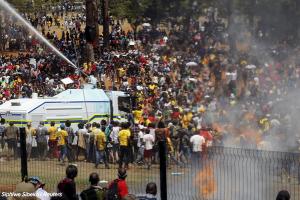
In scenes reminiscent of the apartheid era, students were met by public order police armed with riot shields and stun grenades. They stopped students demanding to be addressed by Higher Education Minister Blade Nzimande, SA Communist Party secretary general, from entering the national assembly. Parliament went into lockdown after EFF (Economic Freedom Fighters) MPs who had demanded the suspension of the mini-budget debate in favour of an emergency sitting on the #FeesMustFall protest movement, were thrown out of the house after defiantly insisting on the debate. Twenty three students were arrested on charges ranging from violations of the Gatherings Act, public violence carrying a minimum of five years imprisonment and high treason for contravention of the National Key Points Act which protects various “strategic” installations and buildings.
A UCT court order cited not only the SA Student Congress (Sasco) and Pan African Students Movement (Pasma) but set a legal precedent by including the hashtag #FeesMustFall as a respondent. It is to last until 23 November. The court order was enforced by riot police attacking students using batons and tear gas. Mimicking the kragdadigheid (authoritarianism) of the apartheid regime, other universities took similar action in the preceding weeks. Stellenbosch University was granted an interdict banning any “disruptive activity” until December.
Months before the past 10 days of protests against fee increases, Wits University reacted to student activity in draconian fashion. The university authorities secured a court order banning the EFF student branch and prohibiting it from participating in the student representative council elections following scuffles between the EFF and the ANC-aligned Sasco during election hustings. The University of Johannesburg (UJ) took similar action. Simultaneous demonstrations took place on 6 October at UJ and Wits, organised by students, workers and academics under the banner of the #Oct6Movement. The demonstration was locked out at UJ. At Wits management threatened to hold the SRC liable for the damages claimed by a private company whose advertising on campus that day had been disrupted.
In a belated realisation of the depth of student anger, Wits Vice Chancellor, Adam Habib, flew back from a conference on Higher Education that coincided with the student occupation of Senate House, to join students on the concourse, insisting he was not being held hostage. He remained squatting on the floor beyond mid-night until he announced the suspension of the increases, pending further negotiations between the Wits Council and the students.
This was greeted as a major victory and inspired students across the country to demand 0% increases, as encapsulated in the #FeesMustFall that reflected the mood of all students. UJ students, whose management had not yet announced its plans, demanded that they immediately reveal what their proposed increases would be.
Discontent simmering for years
Whilst the student uprising appears to have exploded from a clear blue sky, they are, in fact, the culmination of a discontent that had been simmering for years, with tertiary student protests confined, in the main, to what are known as historically black universities (HBUs). In a neo-liberal rationalisation process following the ANC’s adoption of the neo-liberal Growth Employment and Redistribution programme in 1996, all the HBUs were merged with historically white universities (HWUs).
Presented as a deracialisation process to lay the basis for equal education access for all races, rationalisation was, in reality, a cover for cuts in subsidies to tertiary education and the corporatisation of tertiary education institutions, as well as the closure of teacher and nursing training colleges. HBUs remained underfunded, second class tertiary education Bantustans. They cater overwhelmingly for black working class students and have become, for years now, the centre of protests against financial and academic exclusion and unaffordable accommodation.
What sets the #FeesMustFall apart is that it originated at the HWUs and has now spread across all universities. These former bastions of white privilege have over the years experienced a huge influx of initially mainly middle class black students – the sons and daughters of new black middle class that had developed rapidly, especially during the boom years of the late 1990s up to the mid-2000s.
Under pressure to change the racial profile of the HWUs, the government created the National Student Financial Aid Scheme (NSFAS) – a loan scheme – and, at the same time, exerted pressure on HWUs to introduce special programmes to ease access to black students. This changed not only the racial demographic but also the class profile of HWU. Although whites are still a majority at Stellenbosch University – the academic seat of Afrikaner nationalism, with lectures still conducted in Afrikaans – blacks make up 70% at Wits.
As pressure on the purse increased following the 2008 global economic crisis, government cut grants to universities from 49% to 40%, reducing overall spending on tertiary education to just 0.7% of GDP – which is lower than even in Ghana and Senegal. Management made up the shortfall with steep increases in fees that went up from R7.8bn to R12bn from 2000 to 2012. Savings from outsourcing of services that commenced in 2000 – which meant retrenchments and savage cuts in wages and conditions for workers — as well as income from the private sector, could bring in only so much for institutions that were converted into private companies run for profit, with exorbitant salaries for senior management. All but one of the country’s 26 universities made a profit last year (the highest, Stellenbosch, raking in R1bn).
To exacerbate matters, government lowered the matric (final year of schooling) pass requirement to 30%, resulting in a huge influx into the HWUs, as well as new further education and training colleges. Predictably NSFAS was unable to cope with demand. Collections from its loans to over 400,000 students at universities and technical colleges dropped by R100 million in a year. Forced to write off R300m last year for students registered as “deceased”, it eventually became technically insolvent through a combination of a failure to recover loans from students unable to continue their studies or to find jobs after graduation and the rampant looting that has become a special pastime of this government.
The crisis that has burst out at the top is, in reality, the spillage from a crisis that affects the entire education system laying bare the accumulated contradictions of the past twenty one years of the end of apartheid and the introduction of bourgeois parliamentary democracy. Only 50% of those who start school reach matric, the twelfth grade. 500 000 disabled primary and high school learners are excluded from the education system. The culling of black students continues at tertiary level, with financial and academic exclusion resulting in less than half of the small number lucky enough to enter university managing to graduate. The majority are forced to leave as results are withheld for non-payment of fees and fees make it impossible to even consider applying. Nearly 80% of the country’s population is black, but the gross participation rate of blacks in higher education is less than 15%! Thousands of those who do graduate, against the odds, end up jobless in a stagnant economy. This year’s fee increases for a population whose last hope is education, were the last straw.
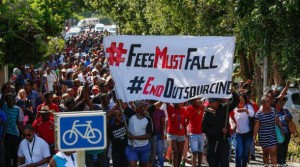
The backdrop to the student uprising is the worst economic crisis since the end of apartheid. The one million jobs lost after the 2008 world financial crisis has never been recovered. After a 1.3% contraction in the second quarter, the economy could have entered its second recession in five years the by the end of October. The government’s much vaunted neo-liberal National Development Plan envisages reducing 26% (according to official understated figure) unemployment rate to 6% by 2030 but only provided the economy grows by an average of 5.4% per annum till then. This is clearly Utopian. Economic growth forecasts have been revised downwards to 1.4%, this year, from the overly optimistic forecasts in the February budget. Growth is not expected to recover beyond this level until at least 2018. Buffeted by a deficit in the current account that has seen a drop in the value of the Rand by 21% against the US$ this year, and a budget deficit of 4.8% that has placed the country on the edge of a fiscal cliff and the threat of a ratings downgrade to junk status, there is no room for manoeuvre and certainly not for increases in the education budget (already the biggest expenditure item in the budget).
Poverty
Despite historically low interest rates, at 9.5% prime, they still mean that debt — 19m of 31m credit active consumers are unable to keep up with repayments — makes up 75% of annual household income. An estimated 10 000 homes are repossessed annually. Fifty four per cent % live in poverty, with 14m going to bed hungry, every night. The black diamonds, as the new black middle class has been described, have turned out to be “zero-carat diamonds”, in the words of one commentator, sinking back into the ranks of the pauperised working class from which they graduated only yesterday.
The government has reacted to events like inhabitants of a parallel universe. They ignored the 21 October protests outside parliament in the belief that Blade Nzimande’s hastily hatched deal with Vice Chancellors to cap the increases to inflation (6%), had put a lid on the protests. As always in conditions of mass protests that threatens the ruling elite, that deal, agreed without any negotiations with students, had the opposite effect. It infuriated the students and wetted the appetite for more. The arrogant complacency was captured in Nzimande’s jocular remark that if the students do not accept the 6% cap, a #StudentsMustFaLL should be started.
By 22 October, President Zuma echoed ANC secretary general, Gwede Mantashe’s acknowledgment that the student demand for no increases was reasonable and understandable. The provocative ‘high treason’ charges laid against protesting students were hastily withdrawn and arrested students – including the sons of ANC stalwart and former Director General in the Office of the President, Frank Chikane, and UCT Vice Chancellor – released with a warning. Zuma was due to meet with Vice Chancellors on 23 November.
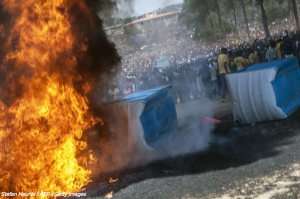
The general revulsion against the draconian reaction to the students will deepen the divisions in the ANC. This is evident in the incoherent response of its different structures. The treason charges, in particular, had an incendiary effect, comparable to the charging of the survivors of the Marikana miners’ massacre with the murder of their comrades under the apartheid Doctrine of Common Purpose law. The spineless ANC Youth League’s call for Nzimande’s head has been denounced by the Young Communist League. The ANC’s Gauteng province, is already at loggerheads with the ANC nationally over the imposition of e-tolls which are being boycotted in the biggest spontaneous act of civil disobedience in the post-apartheid period. ANC Gauteng, fearing the loss of Johannesburg, Tshwane (the capital Pretoria) and Ekurhuleni in next year’s local government elections, came out in support of the students.
As Zuma approaches the end of his second term as president, the succession battle has intensified. He has presided over the loss of over 400,000 members, as he reported at last weekend’s ANC National General Council (the party’s highest decision making body between five-yearly conferences). This more than wiped out the membership surge to 1.2m that followed his election in 2007. In the circumstances, a retreat on fees cannot be excluded. Zuma has been weakened. The ANC is more deeply divided than before the split that followed the toppling of former ANC leader and President, Thabo Mbeki, in 2007. The coalition of the ANC, SACP and Congress of SA Trade Unions (Cosatu) that brought Zuma to power, lies in ruins. It is split following the expulsion of its biggest affiliate, the 320,000-strong metal workers’ union, Numsa, for breaking with the tripartite Alliance of the ANC, SACP and Cosatu and its announcement of plans to launch a United Front, a Movement for Socialism and a Workers Party. These events could give a new impetus towards the stalled development towards a mass workers’ party
Rapid development of consciousness
A striking feature of the student movement has been its non-racial and disciplined character and the rapid development of consciousness, as well as the fact that not one of the traditional student organisations or the new Economic Freedom Fighters (EFF) was able to command leadership. The movement is entirely independent politically and has cut across all formations. The new black Democratic Alliance party leader, Mmusi Maimane, was chased away from the UCT demonstration, as were EFF leaders.
The movement at the historically white universities (HWUs) started as protests at University of Cape Town (UCT) and Rhodes University against continued racial discrimination and the demand for the removal of the statue of arch-imperialist Cecil John Rhodes at the former and the renaming of the latter. Students at Stellenbosch, the University of the North West and the University of the Free Stat demanded a change in language policy from Afrikaans, as the language of instruction, reflected in varieties of “Open Stellenbosch” slogans on banners.
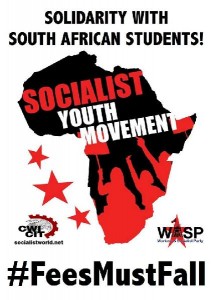
The removal of the statue raised the confidence of the students, with demands now for the “transformation” of the universities. The underlying class issues in these demands soon broke through the shell of the language of black consciousness in which it was couched. At UCT, Rhodes, UJ and Wits solidarity committees took action in support of workers demanding insourcing of outsourced services and workers. Demands have now developed beyond a freeze in fees in favour of free quality education for all, the resignation of the Nzimande and the government itself.
The events of the past ten days have had an electrifying effect. There has been a mass outpouring of sympathy for the students and revulsion at police brutality and the ANC’s callous indifference. Against the epidemic corruption, the claims that there is ‘no money’ will not wash but inflame anger.
The Times reported on 23 November that a Cape Town mother, upon hearing that her son was in confrontation with police at the Free State University, packed a trailer with food, cooking utensils and packets of soup and drove to support him. Community members are joining the students and bringing food and water. A water delivery company owner arranged a convoy to supply students with water in the Free State. In Pretoria, a pizza outlet supplied 500 pizzas to protesting students.
At a demonstration at the Union Building (government offices) in Pretoria, on 23 November, members of the Workers and Socialist Party (Wasp) and the Socialist Youth Movement called for an escalation of action; a national assembly of all student leaders to form a new mass democratic , accountable student organisation and for a mass workers’ party on a socialist programme. The past ten days have shaken the ANC to its core. This marks a new turning point in events that were set into motion by the Marikana massacre. It is seen by many as the South Africa’s own ‘Arab Spring’ #WorkingClassMustRise


